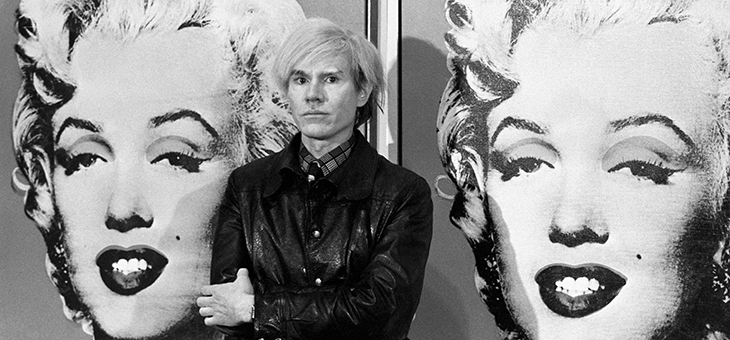With its bright colours and impish humour, it’s almost hard to believe that this year, the pop art movement is 72 years old.
It was such an exciting new wave when it first came about in the 1950s and ’60s, unlike anything else that had come before it, turning traditional expectations of fine art on their head.
One of the most popular pop artists, Richard Hamilton, describes the style best: “Pop Art is: Popular (designed for a mass audience), Transient (short-term solution), Expendable (easily forgotten), Low cost, Mass produced, Young (aimed at youth), Witty, Sexy, Gimmicky, Glamorous, Big business.”
It’s now been 72 years since the term ‘pop art’ was first used, so we spoke to art historian Dr Laura-Jane Foley to get the lowdown on everyone from Andy Warhol to Richard Hamilton and understand a bit more about their legacy today.
The difference between British and American pop art
There’s no doubt Andy Warhol is the leading light in the pop art movement. But while his name might be the one everyone recognises, Dr Foley really wants British artists to get the recognition they deserve, too.
Both countries were “reacting to abstract expressionism”, Dr Foley explains, but “in Britain, it was almost like a pastiche of popular culture in America. We had irony and a sense of satire because we were across the ocean.
“It was very different to pop art in America, which was made by people reflecting on their own culture, so that sense of irony was missing,” she adds.
In the US, there was a particular obsession with brands. Art is traditionally seen as an elevated form, unsullied by the realities of modern life. However, pop artists turned this snobbish principle on its head by featuring the most mundane and banal of advertising and brands – everything from Andy Warhol’s Campbell soup cans to his interpretation of the Coca-Cola bottles. This obsession with brands made pop art a more accessible and democratic art form.
British pop art heavily drew upon brands as inspiration, too, but it was done more in a way of making fun of consumerism, rather than indulging in it like Mr Warhol was often seen as doing.
Andy Warhol and the cult of celebrity
Mr Warhol will forever be remembered for his obsession with celebrity. “He was very aware of how he was positioning his work,” Dr Foley explains. “Think of all the well-known celebrities of the age who are still famous now that he selected – from Mick Jagger to Marilyn Monroe. He was always thinking about how he could position himself to get fame.”
It’s this total self-awareness and desire to be in the spotlight – and stay there – that means Mr Warhol has even been compared to the Kardashians. This isn’t a new idea – back in 2015, i-D wrote an article with the headline: ‘Is Kim Kardashian West the Andy Warhol of our time?’
This isn’t a huge leap. Mr Warhol was obsessed with ‘selfies’ (although they weren’t called that at the time, of course), taking many Polaroids of himself and even transforming them into artworks. Kardashian West is the same – except selfies are a whole lot easier now, thanks to iPhones and apps like Facetune.
Pop art’s legacy
The whole point of pop art was to be controversial and outside of the norm – which is why it’s quite ironic, in some ways, that the likes of Andy Warhol and Roy Lichtenstein are now taught at universities.
“In a sense, maybe they’d be disappointed they’ve become part of the canon,” Dr Foley muses. “They were trying to do something new and different and now they’re part of the curriculum. Artists always start off with ideas of changing and revolutionising things, but then they actually become part of the establishment, and the next generation comes in and tries to change things!”
Artists who have been influenced by the movement
It’s not just the Kardashians who have similarities with Mr Warhol and pop art’s obsession with the cult of celebrity – there’s a whole generation of artists who are the same.
“It almost looks like Damien Hirst has based his career on Mr Warhol,” says Dr Foley. “It’s like a mirror in that he has great ideas and grand plans, and then he gets someone else to execute them. Damien Hirst is very skilful at manipulating his own persona, and that’s something that Mr Warhol did.”
This idea of an artist manipulating their image has gone global, and Dr Foley adds: “Ai Weiwei is another who I would say knows how to curate his own image and project his own persona.”
Dr Foley isn’t the first to draw comparisons between the Chinese artist and Mr Warhol – in 2015, the National Gallery of Victoria in Australia put on a joint exhibition of the two. On the surface, the artists deal with completely different themes – Andy Warhol with 20th century American life and Ai Weiwei with the state of China in the turn of the century – but seeing them together shows that they both love to subvert popular culture and are similarly iconoclastic.
Indeed, it’s particularly telling that Mr Weiwei was involved in developing the show – like Mr Warhol, he’s keenly aware of curating his own image.
As Dr Foley notes: “I think this idea of connections between artists is really important.” After all, it’s exhibitions like this that will help keep the pop art movement feeling fresh, and opening it up to new audiences.
What do you think of the pop art movement? Do you have any pop art prints?
– With PA
If you enjoy our content, don’t keep it to yourself. Share our free eNews with your friends and encourage them to sign up.
Related articles:
https://www.yourlifechoices.com.au/travel/destinations/art-taken-too-far
https://www.yourlifechoices.com.au/fun/entertainment/50-years-without-the-beatles
https://www.yourlifechoices.com.au/fun/entertainment/psycho-turns-60

